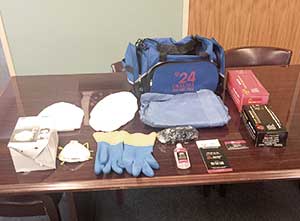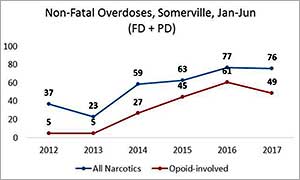
In addition to receiving specialized training in handling hazardous synthetic drugs, Somerville police officers have been issued biological protective equipment specifically designed to protect them in the field.
By Jim Clark
Law enforcement and first responder personnel have been put on alert after a series of dangerous encounters with users of fentanyl and other opioid derivatives led to harmful exposures to the potentially lethal substances.
Last week, three Chelsea police officers were hospitalized after dealing with three men who had passed out after overdosing in a van that had crash into another vehicle.
According to reports, the three officers were exposed to the fentanyl while administering Narcan to the unconscious men in an attempt to revive them.
Similar incidents have been reported throughout the area, prompting police, fire, and emergency responders to establish strict guidelines and safety procedures while being potentially exposed to harmful drugs in the field.
According to Deputy Chief Paul Trant, the Somerville Police Department has been actively engaged in training officers to deal with the problem safely and effectively.
“SPD Lieutenant Vivolo has conducted training for the entire department in June regarding Carfentanyl and Fentanyl and other hazardous synthetic drugs,” Trant said. “All police officers were advised of the hazards concerning these drugs. All officers have been trained on how to respond to calls where suspected hazardous drugs may be present.”
These types of calls reportedly included car accidents, search warrants and calls for overdoses.

According to the SPD, non-fatal overdoses in Somerville remained steady for the first six months of 2017, and reported opioid overdoses declined 20%.
“During this training, a company called 24 Trauma conducted a presentation regarding hazardous crime scenes and donated biological protective equipment which is in each front line cruiser,” said Trant. “This equipment includes, heavy gloves, goggles, protective masks and booties for shoes. There is also a set of protective equipment in the transport wagon.”
Trant also points out that the SPD has doubled the supply of Narcan in its cruisers due to the strength of the new drugs.
According to information provided by the Drug Enforcement Administration (DEA), fentanyl and fentanyl related compounds such as carfentanyl and acetyl fentanyl are synthetic opioids.
Drugs in this group have varying but often very high levels of potency. In recent years they have become more widely available in the United States and grown as a threat to public safety. It only takes a very small amount of fentanyl or its derivatives- which can be inhaled or absorbed through the skin or mucus membranes (such as being inhaled through the nose or mouth) to result in severe adverse reactions. As a consequence, not only are users exposed to danger, but so are others who encounter them including the general public, first responders, and law enforcement.
Somerville Police Chief David Fallon is adamant in his belief that both the public and law enforcement and public safety personnel need to be informed and advised how best to deal with this problem.
“The use of fentanyl and its derivatives as cutting agents by narcotic dealers is extremely concerning and has been a game changer in regards to how the SPD responds to calls where there is a possible presence of such substances,” Fallon says. “Alarmingly, opioid overdoses killed four and a half times more people in Massachusetts than motor vehicle crashes during the first half of 2015. It is easy to say that one overdose death is too many (and it is), but here at the Somerville Police Department we work every day to prevent such incidents. A few years back we developed the Community Outreach Help and Recovery Office which works with members of our community afflicted with the disease of addiction. Our COHR Office consists of a Licensed Clinical Social Worker and a Licensed Drug and Alcohol Addiction Specialist along with many graduate level interns. We are educating our officers to work with community partners and resources to make every attempt to assist people with recovery efforts. A possible feature on our COHR office would go a long way in education the public regarding resources in the community.”












Reader Comments